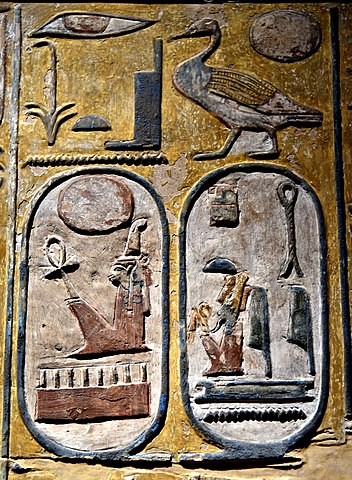Cartouches are fascinating ancient Egyptian symbols that have a rich history and cultural significance. They are oval or oblong shapes that enclose a series of hieroglyphs, usually representing the name of a pharaoh or a deity. Here is an exploration of the history of cartouches and their importance in ancient Egypt:
1. Origins:
- The term “cartouche” is derived from the French word “cartouche,” which means “cartridge” or “bullet.” This term was used due to the resemblance of the oval shape to a cartridge case.
- Cartouches first appeared during the Middle Kingdom period (circa 2055-1650 BCE) of ancient Egypt, although similar oval-shaped symbols existed earlier.

2. Symbolism:
- Royal Significance: Cartouches were primarily used to enclose the names of pharaohs and their queens. The use of a cartouche indicated the person’s royal status and divine protection.
- Divine Connection: The oval shape of the cartouche was thought to represent a protective rope or belt, symbolizing the unification of the king with the cosmic order and the gods.
3. Usage:
- Pharaonic Names: Cartouches were commonly used to enclose the pharaoh’s birth name (nomen) and throne name (prenomen). Each pharaoh had several names, and the cartouche helped differentiate them.
- Deity Names: In some cases, cartouches were also used to enclose the names of deities and other important figures in religious inscriptions and texts.
4. Construction:
- Cartouches were typically inscribed with hieroglyphs, which could be read from right to left or left to right, depending on the direction of the hieroglyphic script.
- The oval shape of the cartouche often had a horizontal line at the base, symbolizing the ground line upon which the cartouche rested.
5. Preservation and Legacy:
- The use of cartouches provided a means of preserving the names of pharaohs for eternity. This has greatly aided modern historians and Egyptologists in identifying and dating ancient Egyptian artifacts and inscriptions.
- Cartouches continue to be of great significance in the study of ancient Egypt and its history. They provide insights into the lineage of pharaohs and their connections to the divine.
6. Modern Interest:
- Cartouches are popular collectibles and souvenirs in modern Egypt and among tourists. They are often personalized with individual names in hieroglyphs.
In summary, cartouches are emblematic of the ancient Egyptian civilization’s deep reverence for its rulers and the divine order. They served as both a practical means of identification and a symbol of royal and divine authority. Today, they continue to captivate the imagination of people worldwide as enduring symbols of Egypt’s rich history and cultural heritage.











